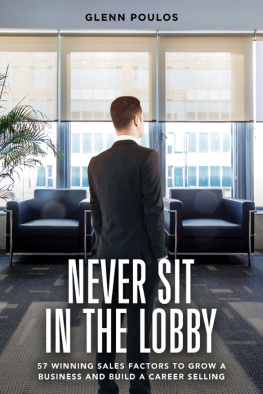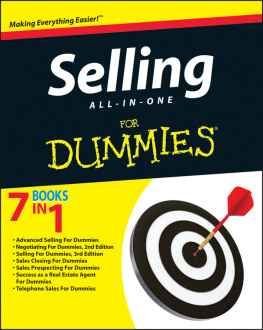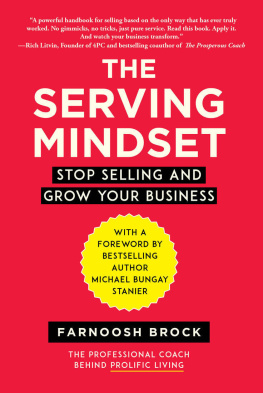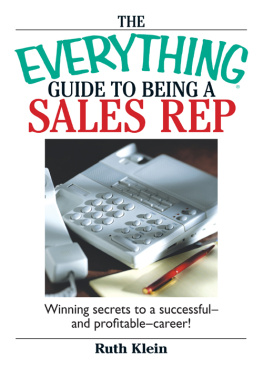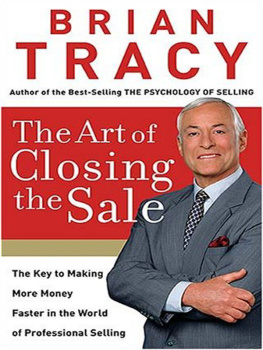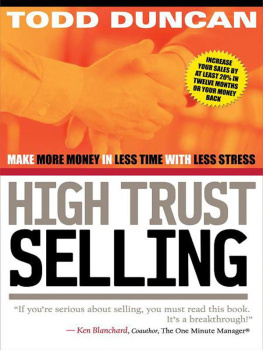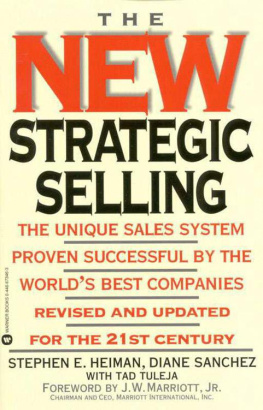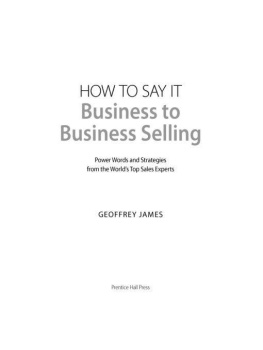
Copyright 2021 Glenn Poulos
All rights reserved. No part of this publication may be reproduced, distributed, or transmitted in any form or by any means, including photocopying, recording, or other electronic or mechanical methods, without the prior written permission of the publisher, except in the case of brief quotations embodied in critical reviews and certain other noncommercial uses permitted by copyright law. For permission requests, write to the publisher, addressed Attention: Permissions Coordinator, at the address below.

www.oakbluepress.com
ISBN: 978-1-7779391-0-6 (print)
ISBN: 978-1-7779391-1-3 (ebook)
Ordering Information:
Special discounts are available on quantity purchases by corporations, associations, and others.
For details, contact:
www.oakbluepress.com

This book of rules and advice is for the salesperson and the consumer, and was created from the knowledge Ive acquired during my decades of experience in sales. While I dont have a formal writing background or consider myself to be a writer, writing and teaching are things I enjoy. Any time I can hear my own voice in my ears, its usually a good thing for meparticularly when Im lecturing a group on sales, consumerism, and what motivates people at a raw emotional level. To me, discussing these subjects where I know the subject matter down pat sure beats the times I engage in topics better left to others. When I do happen to stray from my comfort zone, the reaction I get are usually painful hmms and haws, umms and awws from the act of trying to BS my way through a topic. This is what I like to call M-Sagging, or Making Shit Up Again. I can tell you from experience nothing makes a customer want to run faster than the sense that a salesperson is full of crap.
Throughout the years, Ive built my belief and strategy system in the office trenches, spending thousands of hours in the field, on the phone with customers, and working with salespeople in several successful companies. My experience ranges from being a salesperson to managing teams within the companies I founded, which includes the executive level (the managers). Within my firms, I often reflect on moments and tell stories about my experiences. The traits of people or the memories of these places are used to anchor the lessons in human behavior into my memory.
This has morphed into a set of factors, with the names created being inspired by the person, place, or thing that first taught me the lesson. Every factor is a concept Ive created that has a takeaway motivation for the seller and customer. By relating to these experiences, I hope that you will be able to understand the primary motivation behind the seller and the customer in order to help you adjust your negotiation strategies accordingly.
These are some of the key factors that have shaped my career. I hope these techniques can inspire, challenge, and enlighten you, too.
CHAPTER 1
I started selling before technology changed everything.
In 1986, we had a telegraph machine connected to a printer. When we had to send a quote, an office secretary would type it onto three-page triplicate forms of layered sheets of white, yellow, and pink carbon copies that could be separated by folding and ripping off the papers edges. This is the tedious process we would use before we had to send the quote in the mail.
Within a few years, my office got a fax machine that connected to a telephone line, allowing us to receive and print data sent from other fax machines. The fax machine at the time was revolutionary, but in my opinion, was not for the better. People went from waiting a few days to a few minutes to receive their quote. This caused customers to lose their patience. Before fax machines we had about a week to put together a quote, add a letter if needed, and drop it off. Now, everything was expected immediately. As you might imagine, internet and email have shortened that time frame even further, from a few minutes it takes for a fax machine to process to a few seconds.
But the factor never fax the facts or ship the shit isnt about the underlying technology as much as it is a call to action to make sure electronic correspondence isnt the primary means of communication with your client. By this, I want to emphasize the importance of avoiding electronically submitting proposals, quotes, and literature to the customer behind a veil of false security. The same holds true for demo equipment and other items you need to provide the customer during the sales process.
For example, in my line of work, we often need to demo equipment were trying to sell to the customer so they can verify it meets the specs or performs certain measurements. This could hold true with tools and machinery, paper products, or software. All these items should be hand delivered so you can see the whites in your customers eyes. This face time offers you a chance to strengthen your connections with them while also completing some very important detective work. During these drop-offs, you might bump into a competitor, see their items, or notice invoices for purchases sitting on the customers desk.
When you drop off a quote, you should always ensure that the pricing is easily visible when you pass it to the customer while guiding them to check it out. You can even say something like, Hey Bob, let me show you, heres the unit you asked for, and you can see the total investment at the bottom. This will cause them to look and see what the bottom line is. Once theyve seen the price, I ask, So at first glance, how does our pricing look? The goal isnt to close someone on the spotespecially if youre making high-value sales. However, if your pricing isnt within range, youll often know quite quickly. If the customers eyes start to bulge or open wide in amazement, these important signals will be pretty easy to notice.
Over the years, Ive heard a thousand excuses from salespeople who wouldnt or couldnt drop off sales information and product demos to their customers. Suffice to say, fear is the most common reason, as most people dont like being rejected. When they fax the facts, they can send it and forget it. It can hurt being told no again and again, and not having to face rejection can make it easier to deal with.
Laziness is another culprit. Its simpler and more efficient to work over email. When a boss says, Hey Jack, did you get that proposal for the new Quantum Exasperator to Sam over at AcmeTech Solutions? A common response might be, Sure did, Glenn. I emailed him yesterday, confident in their mind they have done their job. At this point, I need to sit down with the salesperson and explain theyre acting like a post office and not a salesperson. I could hire a virtual assistant working half way around the world for $10 per hour who can mail, fax, email, or e-quote the customer. Im paying the salesperson to be in front of customers and make it to happen, as my favorite Francophone sales guy from Quebec used to say.
Sales are won person-to-person. Over email, you wont be able to pick up clues that can give you an edge. Even if you lose the sale because of pricing or specifications, youll gain a lifetime introduction and the ability to build a connection with the customer that could turn into a sale down the road. This also allows you to garner a deeper understanding of their thought processes, decision-making, and buying cycles.
Next page
